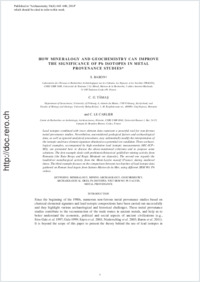How mineralogy and geochemistry can improve the significance of Pb isotopes in metal provenance studies
- Baron, S. Laboratoire des Travaux et Recherches Archéologiques sur les Cultures, les Espaces et les Sociétés (TRACES), CNRS UMR 5608, Université de Toulouse 2, France
- Tămaş, Calin-Gabriel Department of Geosciences, University of Fribourg, Switzerland - Faculty of Biology and Geology, University Babeş-Bolyai, Cluj-Napoca, Romania
- Carlier, C. Le Centre de Recherches en Archéologie, Archéosciences, Université Rennes 1, France
-
01.08.2014
Published in:
- Archaeometry. - 2014, vol. 56, no. 4, p. 665–680
mineralogy
mining archaeology
geochemistry
archaeological ores
Pb isotopes
NIST SRM 981 Pb values
metal provenance
English
Lead isotopes combined with trace element data represent a powerful tool for non-ferrous metal provenance studies. Nevertheless, unconsidered geological factors and archaeological data, as well as ignored analytical procedures, may substantially modify the interpretation of the isotopic and trace element signature obtained as a potential ore candidate. Three archaeological examples, accompanied by high-resolution lead isotopic measurements (MC–ICP–MS), are presented here to discuss the above-mentioned criticisms and to propose some solutions. The first example deals with prehistoric/historical gold/silver-mining activity from Romania (the Baia Borşa and Roşia Montană ore deposits). The second one regards the lead/silver metallurgical activity from the Mont-Lozère massif (France) during medieval times. The third example focuses on the comparison between two batches of lead isotope data gathered on Roman lead ingots from Saintes-Maries-de-la-Mer, using different SRM 981 Pb values.
- Faculty
- Faculté des sciences et de médecine
- Department
- Département de Géosciences
- Language
-
- English
- Classification
- Mineralogy
- License
-
License undefined
- Identifiers
-
- RERO DOC 211437
- DOI 10.1111/arcm.12037
- Persistent URL
- https://folia.unifr.ch/unifr/documents/303756
Statistics
Document views: 133
File downloads:
- pdf: 319
